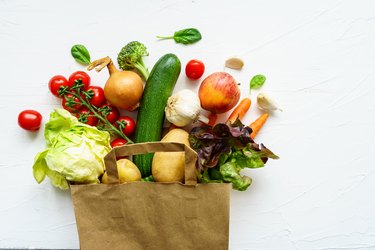
Gamma-glutamyl transferase (GGT) may be a mouthful, but the most important thing to know is that high GGT levels may indicate liver disease. To better understand GGT in relation to your health, here's a breakdown on what GGT is all about, and whether the foods you eat can help lower GGT.
GGT is an enzyme found primarily in the liver, according to the U.S. National Library of Medicine. And because liver damage may cause it to seep into your bloodstream, high levels (anything above 61 U/L, per the Mayo Clinic) are considered a telltale warning sign of hepatitis, cirrhosis, pancreatitis, alcohol abuse and more.
Video of the Day
Video of the Day
So, can your diet help? It's possible, according to an August 2016 study in Liver International (LI). That report suggests people with elevated GGT triggered by obesity, drinking, smoking or nonalcoholic fatty liver disease may benefit from a nutritious diet and possibly losing weight if recommended by a doctor.
More specifically, certain foods can help lower GGT, says New York City-based Ashley Baumohl, MPH, RD, assistant clinical nutrition manager at Lenox Hill Hospital.
The liver is "the workhorse of the digestive system," Baumohl says. And "while there isn't an exact mechanism for identifying the root cause of elevated GGT, there are some known associations within our dietary patterns," she says — some positive and some negative.
Say Yes to Fruits and Veggies
The American Liver Foundation (ALF) hails fruits and vegetables for their general ability to boost liver function. Both are GGT-lowering winners, Baumohl says, adding that more of either also means more fiber, which is linked to a lower risk of heart disease.
Both also help up vitamin, mineral and antioxidant intake, Baumohl says. And that could mean more glutathione, an antioxidant "also tied to reducing GGT levels," she says. She points to sulfur-rich foods as a good source, including:
- Onions
- Garlic
- Broccoli
- Kale
Hold the Fat for GGT
As for other foods, the effect on GGT is less clear. The ALF generally recommends people with liver disease avoid foods high in salt, fat and sugar. Baumohl adds that GGT levels go up with diets high in saturated fats from foods like:
- Red meat
- High-fat dairy
Consider Coffee
A March 2019 study in Nutrients links coffee with lower GGT and also other liver enzymes like ALT and AST. The researchers pinpoint the many observational studies and reviews that associate coffee drinking with lower risk of liver disease. They note that the antioxidant, anti-inflammatory and anti-fibrotic attributes in coffee may help keep your liver in check.
According to Michigan Medicine, ALT and AST are two additional liver enzymes that, at excessive levels, indicate liver damage.
What About Milk Thistle?
Milk thistle has long been touted as a liver disorder treatment. According to the National Cancer Institute, there are indications that among people with chronic liver disease, this herbal remedy may help control high levels of all three enzymes: GGT, AST and ALT. But the National Center for Complementary and Integrative Health cautions that there’s just not enough rigorous evidence supporting any meaningful liver health benefit.
Grocery Tips for Liver Health
The ALF adds these tips for boosting liver health when you're filling your grocery basket:
- Choose fruits and veggies without high-calorie sauces or added sugar/salt.
- Pick fiber-rich whole grains.
- Grab skinless poultry/fish.
- Choose lean cuts of meat.
- Aim to eat fish at least twice a week, especially seafood high in omega-3s (salmon, trout, herring).
- Opt for fat-free/skim or low-fat (1 percent) dairy.
- Avoid partially hydrogenated vegetable oils aka trans fats.
- Choose monounsaturated and polyunsaturated fats over saturated fat.
- Limit foods and drinks with added sugars.
- Opt for foods with less sodium (and cook with little or no salt).
Be sure to check in with your doctor about what's going on in your body. "If you test high for GGT, don't focus on lowering that number; focus on the disease process likely underway. That's what needs to be addressed," says Samantha Heller, MS, RD, senior clinical nutritionist at NYU Langone Health in New York City.
- Ashley Baumohl, MPH, RD, CDN, CNSC, assistant clinical nutrition manager, Lenox Hill Hospital, New York, New York
- Samantha Heller, MS, RD, registered dietitian; senior clinical nutritionist, NYU Langone Health, New York, New York
- U.S. National Library of Medicine: “Gamma-Glutamyl Transferase (GGT) Test”
- American Liver Foundation: “Liver Disease Diets: A Healthy Diet, a Healthier Liver, a Healthier You”
- Mayo Clinic: “Liver Function Tests”
- Liver International: “Gamma-Glutamyl Transferase—Friend or Foe Within?”
- Nutrients: “Impact of Nutritional Changes on Nonalcoholic Fatty Liver Disease”
- National Center for Complementary and Integrative Health: “Milk Thistle”
- National Cancer Institute: "Milk Thistle"
- Michigan Medicine: University of Michigan: "Liver Function Tests"
Is this an emergency? If you are experiencing serious medical symptoms, please see the National Library of Medicine’s list of signs you need emergency medical attention or call 911.